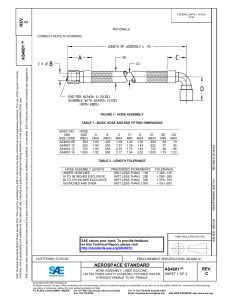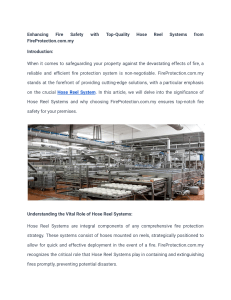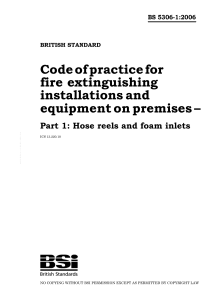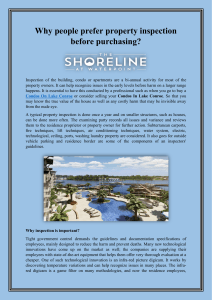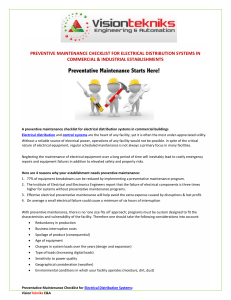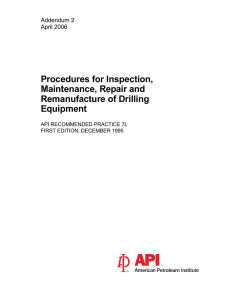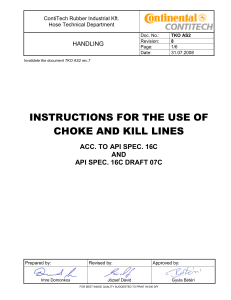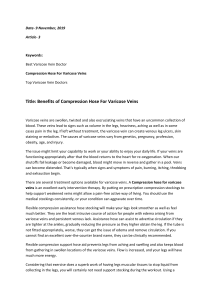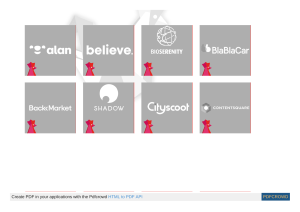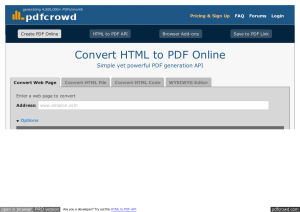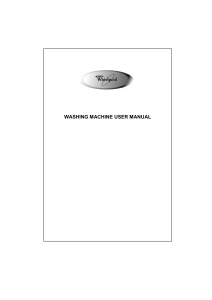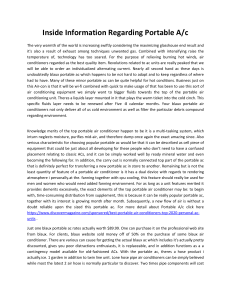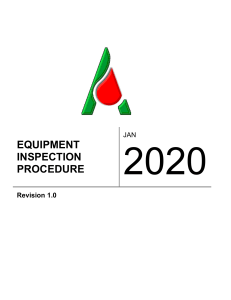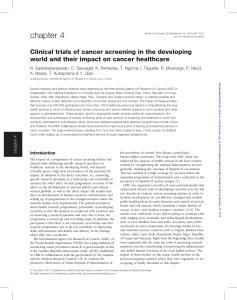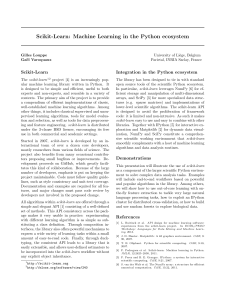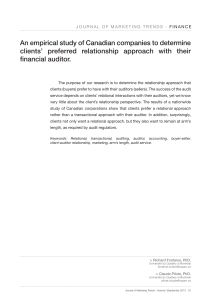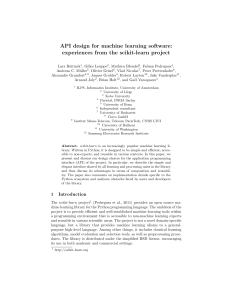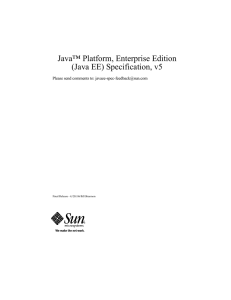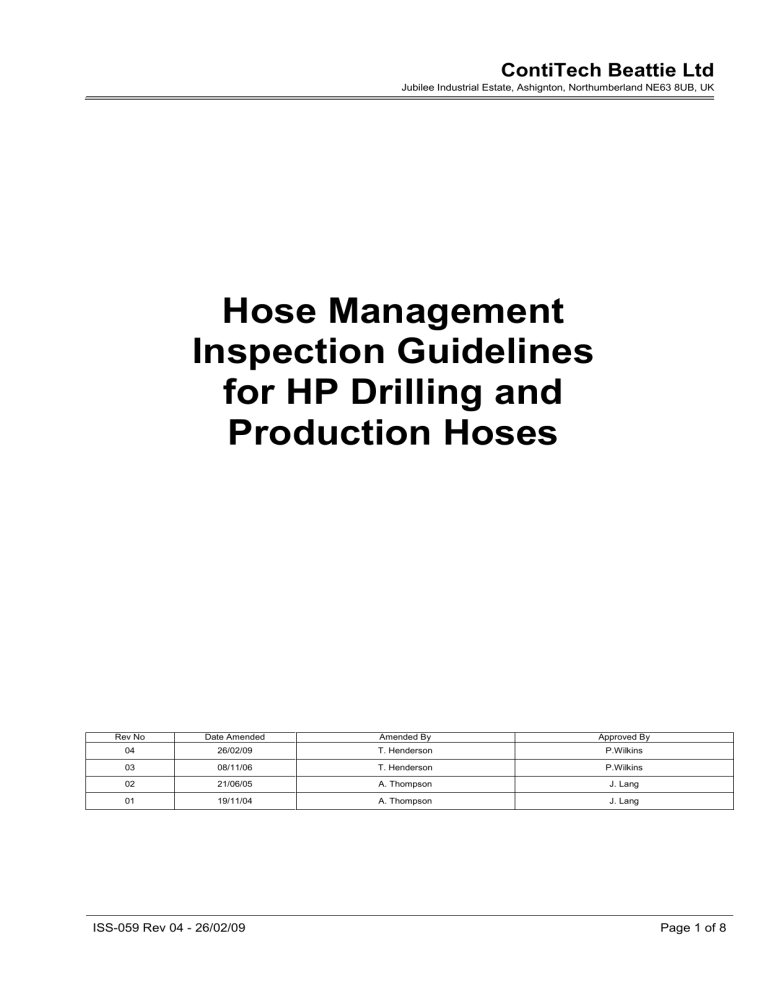
ContiTech Beattie Ltd Jubilee Industrial Estate, Ashignton, Northumberland NE63 8UB, UK Hose Management Inspection Guidelines for HP Drilling and Production Hoses Rev No Date Amended Amended By Approved By 04 26/02/09 T. Henderson P.Wilkins 03 08/11/06 T. Henderson P.Wilkins 02 21/06/05 A. Thompson J. Lang 01 19/11/04 A. Thompson J. Lang ISS-059 Rev 04 - 26/02/09 Page 1 of 8 ContiTech Beattie Ltd Jubilee Industrial Estate, Ashington, Northumberland, NE63 8UB, UK INSPECTION GUIDELINES FOR HP DRILLING & PRODUCTION HOSES 1.0 INTRODUCTION It is essential to afford care and attention to the flexible hose once installed and in service to maintain its integrity and longevity throughout its working life. By embracing the following guidelines and operating the hose within its design parameters, the operator can seek to maximize the service life of the hose. The frequency and degree of inspection is dependant upon consideration of the failure modes of the hose and its criticality and severity of service. It is recommended that the operator records all inspection data for the hose. This will be used by the manufacturer in evaluating the condition of the hose during the inspection schedules. See appendix 1 for inspection record sheet. In general the hose should be inspected on a regular on-going basis. The frequency and degree of the inspection should as a minimum follow these guidelines: Every 3 months (or during installation/removal) Visual Inspection Annually In-situ pressure test Initial 5 years service Major inspection 8 / 10 years service 2 Major inspection (**) nd **NOTE There are a number of critical elements in the hose that cannot be thoroughly checked through standard inspection techniques. The listing and sketch that follow detail these. Away from dissecting the hose body, the best way to evaluate the condition of the hose is through review of the operating conditions recorded during the hose service life, in particular maximums and peak conditions (these are detailed in para 4). 2.0 CRITICAL ELEMENTS Rubber liner The main sealing membrane Inner metallic tube Supports the rubber liner under decompression Steel reinforcing cables Main strength of hose body providing pressure retention Rubber cover External sealing compound preventing water ingress to hose body Bonded hose coupling End coupling retention ISS-059 Rev 04 - 26/02/09 Page 2 of 8 ContiTech Beattie Ltd Jubilee Industrial Estate, Ashington, Northumberland, NE63 8UB, UK The diagram shows the main elements of the hose and coupling. BUILT IN TAPERED RUBBER BEND STIFFENER 3.0 INSPECTION SCHEDULE 3.1 3 Month Visual Inspection The hose is visually inspected externally by a competent person whilst still installed and operating. All observations should be noted and logged. This is a critical early inspection technique where potential damage can be identified early allowing remedial action to be taken before major hose damage is induced. The outer cover of the hose body is visually inspected for signs of looseness, kinks, bulges, soft spots, abrasion, cuts or gouges. The back of the bend stiffener area behind the coupling (see sketch below) should be checked for such signs and any possibility of over-bending. Where the hose is fitted with external metallic guarding along its length, then this should be inspected for signs of cracking, external mechanical damage (eg. denting or abrasion), or bulging indicating possible swelling of hose body underneath. BACK OF BENDING STIFFENER ISS-059 Rev 04 - 26/02/09 Page 3 of 8 ContiTech Beattie Ltd Jubilee Industrial Estate, Ashington, Northumberland, NE63 8UB, UK Particular attention should be paid to areas of near contact of the hose with neighbouring steelwork or equipment. Where possible, the hose should be suitably guarded from potential abrasion or impacting. The end coupling connection should be checked for any signs of leakage. Cuts or gouges in the hose should be addressed immediately. Damage to the outer cover that is not too deep and does not expose the steel cables (shown in pic 1) can be repaired using suitable sealants or patches. However, if this damage exposes the steel cables and corrosion is induced (shown in pic 2), then the strength of the cables is weakened and the hose is not repairable and must be condemned. Pic 1 Pic 2 A hose should be visually inspected every time it is demounted or re-installed. Annual In-Situ Pressure Test: A pressure test should be performed on the hose to verify the integrity of the hose body and its connections. The test is performed on the hose as installed and configured. The test pressure and duration for each hose type are: Hose Type Test Pressure(*) Hold duration API 7K Rotary and Cement 1.25 x Design Pressure 10 mins API 16C Choke & Kill 1.1 x Design pressure 1 hour API RP17b Production & Gas 1.1 x Design Pressure 1 hour API 17K Production, Gas & Liquid Service 1.1 x Design Pressure 1 hour *Test pressure differs from 5 year major inspection. NB: Where it is impractical or not possible to achieve the above pressures, then it is acceptable to consider the maximum working pressure the hose is operating under instead of the design pressure. After the pressure test the hose should be examined for any leaks, especially in the area of the end couplings, any bulging of the hose body, undue twisting or abnormal distortion. Any pressure drop during the test should be recorded and should not exceed 2%. ISS-059 Rev 04 - 26/02/09 Page 4 of 8 ContiTech Beattie Ltd Jubilee Industrial Estate, Ashington, Northumberland, NE63 8UB, UK The opportunity should be taken at this point to record the normal and maximum operating pressures and temperatures the hose has been subjected to over the year. In addition, any uncontrolled (rapid) decompressions accounted for in gas service hoses should also be noted. NB: This information becomes useful when assessing the hose integrity during the major survey. If the hose is removed from its installation at the annual test then the opportunity should be taken to perform an internal inspection. 3.2 5 Year Major Inspection A hose should be considered for a major inspection after it has been in service for a period of 5 years. Thereafter, on a 3-year cycle, ie next major inspection at 8 years. It is recommended that the major inspection be performed by the original hose manufacturer. The hose is to be decommissioned from the installation and ideally brought on-shore for inspection. A thorough examination of the hose shall include: 3.3 External Inspection of the Hose Measure overall length (compare with original manufactured length, if information is available) Ensure hose will lie straight and no bend-set has occurred (this can result from continued operation above the maximum design temperature) Visual inspection of hose body with particular emphasis on the end couplings and bend restrictor area. Observe condition of outer cover – check for looseness, kinks, bulges, soft spots, end coupling movement, cuts and gouges, or abrasion. Where the hose is covered with a metallic guard this should be inspected for signs of cracking, external mechanical damage (eg. denting or abrasion), or bulging indicating possible swelling of hose body underneath. Where the hose is covered with a metallic guard, or a metallic inner carcass is evident for gas service, then the condition of the rubber cover and rubber liner is to be evaluated by reviewing the operation data. The face and sealing surface of the couplings are to be visually checked for signs of cracking, deformation, abrasion or erosion. 3.4 Internal Bore-O-Scope Inspection Video-scope equipment is required to inspect the hose bore and inside surface of end couplings. The hose must be cleaned internally to remove oily traces for good viewing. Observations will be made of the rubber liner for bulges, bubbles, cuts or abrasion. Where a metallic liner is evident the surface is observed for cracks, deformations or abrasion. Where this internal inspection is not performed by the hose manufacturer, it is recommended that the internal inspection is recorded and made available to the manufacturer for evaluation/comment. ISS-059 Rev 04 - 26/02/09 Page 5 of 8 ContiTech Beattie Ltd Jubilee Industrial Estate, Ashington, Northumberland, NE63 8UB, UK 3.5 Pressure Test A pressure test shall be performed on the hose using water to verify the integrity of the hose body and its connections. The hose is to be tested above its design pressure to the values and durations in the table below. The hose is to be monitored during the test. NB: It is not safe to approach any hose under test conditions and the test shall be performed in a suitably safe area/enclosure. The pressure in the hose is raised to the required test pressure and allowed to stabilise then held for the stated duration. The pressure shall be recorded and any pressure drop should not exceed 2%. After the hold duration, the pressure shall be reduced to the design pressure of the hose. At this point the hose shall be observed for any leaks, especially in the area of the end couplings, any bulging of the hose body, undue twisting or abnormal distortion. A measurement can also be taken of the any change in hose length and compared with the measurement prior to the Pressure Test. The permitted elongation should lie within the guidelines in the relevant API Standard. Hose Type Test Pressure(*) Hold duration API 7K Rotary and Cement 1.5 x max Design Pressure 1 hour API 16C Choke & Kill 1.5 x max Design Pressure 1 hour API RP17b Production & Gas 1.5 x max Design Pressure 4 hours API 17K Production & Gas 1.5 x max Design Pressure 4 hours *Test pressure differs from annual in-situ inspection. 4.0 In the case of premature hose failure the operating parameters for the hose shall be reviewed. The hose inspection record sheet shall be updated to include this data and add to the history of the hose. a) b) c) d) e) f) g) h) i) j) Operating pressures Operating temperatures Service medium type, density & viscosity PH levels, Chloride content Concentration of H2S CO2 and aromatic contents. Flowrates (fluid, gas or multi-phase) Sand content (erosion monitoring) Stress levels monitored on connecting equipment (eg. Swivel) Injected chemicals The overall inspection data shall be provided to the manufacturer for evaluation of the hose condition. 5.0 NDT INSPECTION The end connections on the hoses can be dye-penetrant, or magnetic particle inspected on request and charged accordingly. 6.0 HOSE DISPOSAL If at any stage of the inspection the hose is condemned it can be disposed of at ContiTech Beattie or returned for client disposal. ISS-059 Rev 04 - 26/02/09 Page 6 of 8 ContiTech Beattie Ltd Jubilee Industrial Estate, Ashington, Northumberland, NE63 8UB, UK 7.0 CONTACT DETAILS Any queries that arise during inspection or operation of the hoses should be directed to: ContiTech Beattie Ltd Jubilee Industrial Estate, Ashington, Northumberland, NE63 8UB, UK Tel: Fax: Internet: email: +44 (0) 1670 528700 +44 (0) 1670 520535 www.contitechbeattie.co.uk [email protected] ISS-059 Rev 04 - 26/02/09 Page 7 of 8 ContiTech Beattie Ltd Jubilee Industrial Estate, Ashington, Northumberland, NE63 8UB, UK APPENDIX 1 ISS-059 Rev 04 - 26/02/09 Page 8 of 8
